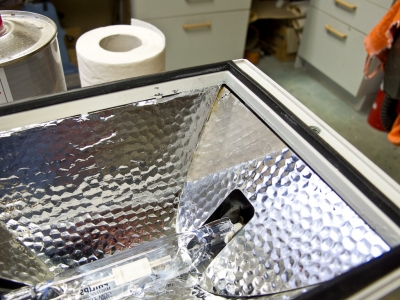Reparatur statt neu
Aus der Reihe: man kann fast alles reparieren. Da ich ja gegen die Verschwendung von Resourcen und die Wegwerfgesellschaft bin liegt das auch nahe, auch wenn es heutzutage aus Zeitgründen niemand macht. Die Außenstrahler gingen nicht mehr, was angesichts der neuen Funktionsweise als Unterwasserstrahler auch nicht sehr verwunderlich war:
Jeder normale Geschäftsmann hätte die Dinger verschrottet und neue gekauft, aber dafür ist unsereins zu sparsam.
Zuerst einmal schraubt man alles auseinder und macht es sauber. Funktional war das Zündgerät hinüber - das hält irgendwie nur so lange wie das Leuchtmittel. Die Ballastspule ist nicht kaputtzubekommen, die funktioniert auch mit leichten Rostspuren. Die verrosteten Schrauben durch neue ersetzt, teilweise neue Kabel, eine 3D-gedruckte neue Dichtung für die Kabelverschraubung stoppte die Frischwasserzufuhr. Ich habe dafür NinjaFlex genommen und nach einer Saison ist die Dichtung noch einwandfrei. Dann noch ein neues Leuchtmittel und das Ding war so gut wie neu. Lediglich der Reflektor war so einfach nicht zu reparieren: durch die Unterwasserbehandlung ist er bis zur Wasserlinie blind geworden. Ersatzteile gibt es natürlich nicht.
Wenn man aber etwas wartet, fällt dem INTJ auch dafür eine Lösung ein: Die Reflektoren sind typischerweise aus glänzendem Aluminium - das habe ich in einem anderen Zusammenhang gelesen. Also kann man sogar das wieder hinbekommen: Etwas Aluminiumfolie zugeschnitten (ist ja auch glänzendes Aluminium), mit Sprühkleber eingesprüht und angerieben - man sieht den Unterschied praktisch nicht. Deshalb: links und mitte neu, rechts noch blind:



Kommentare
Ansicht der Kommentare: Linear | Verschachtelt
An IxTx, not sure yet am :
Is the ignitor the same type as those for fluorescent tubes, or one of those metal cans (maybe there are plastic ones too) that the wires are connected directly to?
If it's the same as for fluorescent tubes, if the lamp goes out and cant be reignited, the ignitor will repeatedly try to ignite it, and if left for long enough, usually hours to days, might be shorter for this type of lamp since it's higher power and thereby higher current than a fluorescent, it will wear out. It's a bimetallic strip in a glass bulb containing inert gas, in this application connected in parallel to the lamp, the higher voltage across the unignited lamp causes a glow discharge which heats the bimetallic strip so that it makes contact with the opposite pole pin in the bulb, short-circuiting the lamp. This connects the inductive ballast across the mains, and when the strip cools, it disconnects - hopefully at the peak of current in the sinewave and thereby stored energy in the inductor - causing a voltage spike that ignites the lamp. The now lower voltage across the lit lamp (usually about half mains voltage), is not enough to re-establish the glow discharge in the igniter, so it doesn't short circuit the lamp and put it out. The bimetallic strip disconnecting is what makes the little "tink" noises when lighting up fluorescent tubes.
If the starter is "part of the fixture", with wires connected by screw terminals or similar, I suppose it uses some clever arrangement with some kind of timing circuits and a power transistor, but I haven't taken any apart or read about them, so I'm not sure. Such a starter not lasting longer than a bulb is obviously bad quality. In this case it might be the water ingress, but I assume that you have more than this example, as I suppose you would have thought that too if this was the only one.
I'm just like you in regard to throwing vs repairing. I mostly do component-level repair on electronics, not professionally but for myself, family and friends. Bad capacitors in switch-mode power supplies are the by far most common problem, and without it, probably 50% of electronics waste would be eliminated.
Stephan Brunker am :
This lamp is Mercury-based and operates with High Voltage, it is not like the simple ones operating with line voltage. And because of that is the electronics package a sealed unit. But as I could find out, the basic problem is the same like you said: The igniter has only a limited number of cycles and after 1.000 oder 2.000 cycles it has reached its end of life. I have similar, just slightly different ones for indoor use and there is basically the same problem. I have like 15 of them for 20 years now, they now have the third bulb each and I also had to replace a couple of the igniters. It just wasn't as bad as the outdoor ones. Or perhaps trying to ignite the faulty bulb over a longer timespan (because I didn't check them regularly) finished the igniter too? It doesn't matter, because that was the part I could get as replacement.
An IxTx, not sure yet am :
Interesting, I've never seen this kind of lamp that uses HV after igniting. Do you know the running voltage?
Anyway, great that they still sell the igniters.
Stephan Brunker am :
I really don't know the voltage. As an INTJ, I am at a "get it running" approach. I just saw the "danger high voltage" sign and the cable with a lot of insulation and that was enough for me to keep my fingers away. And there really was nothing to repair, the igniter was in a sealed case. If you are more into the "how does it work" approach, you are probably an INTP, that is one of the major differences, you can see that in my latest video, for me it simply isn't worth the effort to crack that case open and figure out how it works if I can replace that part for an acceptable cost.